Actioning VoC Feedback Best Practices
According to Gartner stat: 95% of companies collect customer feedback. Yet only 10% use the feedback to improve, and only 5% tell customers what they are doing in response to what they heard. If customers take the time to provide feedback to help call centers improve service, organizations should - take action to improve customer experience (CX).
One of the most crucial aspects of any call center CX strategy is to action post-call customer survey feedback. It is a waste of resources if call centers are unwillingly or unable to action post-call surveys to improve customer service. Unfortunately, for many organizations, the actioning post-call survey feedback tends to be one of the weakest aspects of a call center CX strategy.
You can strongly argue that post-call surveys are the right data to action for improving customer service. However, if a lot of resources are invested in analyzing data, and it is never actioned – it wastes valuable resources. Furthermore, many call centers struggle with actioning post-call survey feedback because they do not know how to use it to improve First Call Resolution (FCR) and customer service performance.
CX operating practices can be an outside-in or an inside-out approach. The difference is the outside-in CX operating practices are based on the customer's perspective. Conversely, the inside-out CX operating practices are based on the organization's perspective. The inside-out approach focuses on actioning internal data, and the outside-in approach focuses on actioning post-call survey data. It is common for the inside-out CX approach to be the company's primary operating practice, which can hinder to use of post-call surveys.
The biggest barrier to not improving FCR and customer service is the lack of management commitment at all levels of management. For example, a low FCR improvement commitment at the individual supervisor level negatively impacts CX performance less than at the VP level, where a low FCR commitment impacts the entire call center FCR performance.
Consistently translating post-call survey insights into sustained action and change initiatives can be challenging.
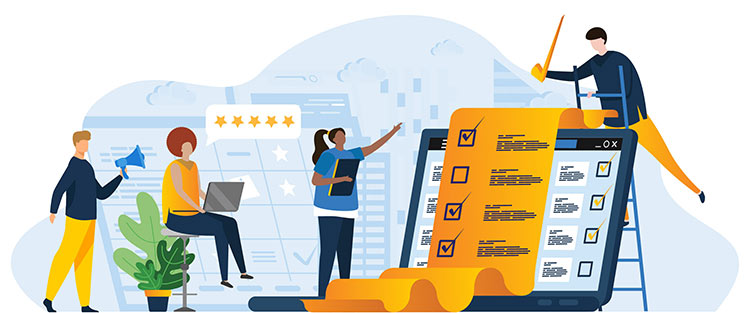
Actioning Customer Survey Feedback
Figure 1 shows best practices for actioning customer survey feedback that SQM uses to counsel clients on how to improve FCR and customer service performance. The following Actioning Customer Survey Feedback Model shows the three distinct stages for actioning customer survey feedback (i.e., Customer Identification, Analyzing Calls, and Improving FCR and Customer Service).
Figure 1: Actioning Customer Survey Feedback Model
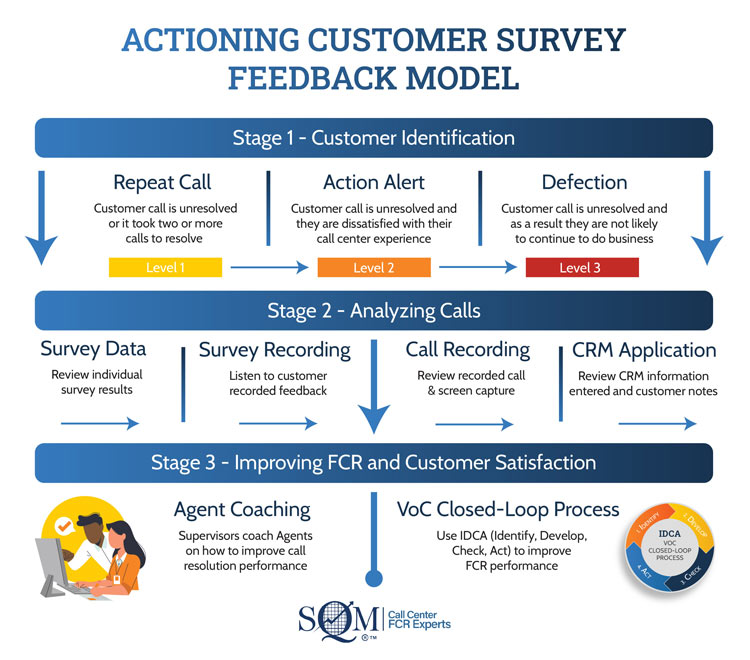
Stage 1 - Customer Identification
The first stage is 'customer identification' for the level of satisfaction/dissatisfaction the customer had with their experience in calling the call center. There are three levels of customer dissatisfaction, with 'Level 1' having the lowest level of customer dissatisfaction and 'Level 3' having the highest level of customer dissatisfaction.

Level 1: Repeat Call
The Customer call is unresolved, or it took two or more calls to resolve. This customer is likely to be, at best, only somewhat satisfied with their call center experience as a result of their call being unresolved or taking multiple calls to resolve. For the average call center, 12% of customers SQM surveyed had their call unresolved. A repeat call represents a great opportunity to understand what happened on the call. After surveying the customer, the 'Level 1' customer call that is resolved does not require further action. However, if the call is unresolved, the supervisor or escalation Agent should action this call within one business day of surveying the customer to resolve the customer's issue or problem. Another option is to have an analyst determine who was the original agent that handled the first call and finds out what happened.
Level 2: Action Alert
The customer call is unresolved, and they are dissatisfied with their overall call center experience. For the average call center, 6% of customers SQM surveyed would be classified as an action alert caller. The 'Level 2' customer call does require action by someone within the organization within one business day of surveying the customer to attempt to resolve their issue or problem. Many call centers SQM works with have dedicated escalation Agents who handle calls in which the customer is identified as a complaint caller during the survey process. Using dedicated escalation Agents is the best practice for ensuring that customers who are identified as action alert callers are contacted to resolve their issue or problem.
Level 3: Defection
The customer call is unresolved. They are dissatisfied with their overall call center experience and stated they might defect. For the average call center, 5% of customers SQM surveyed would be classified as potential customers at risk of defection. The 'Level 3' customer should be contacted by someone within the organization immediately after surveying the customer, or at least within one business day of surveying them, to resolve their issue or problem and achieve customer retention. Many call centers SQM works with have dedicated customer retention Agents who handle calls in which the customer is identified as a potential defection caller during the survey process. The major advantage of using dedicated customer retention Agents for handling defection customer calls is that, in most cases, they have the service recovery skills and proper authority level to resolve the customer issue or problem and hopefully retain the customer.
Stage 2 - Analyzing Calls
The second stage is to analyze why the customer's call was unresolved. Four different analysis areas should be conducted to determine why the customer's call was unresolved (e.g., survey data, survey recording, call recording, and CRM). Each area provides unique insights into what happened on the call and insights into the opportunities for coaching Agents to improve their call resolution performance and improve the call center's people, process, and technology practices to improve FCR performance.
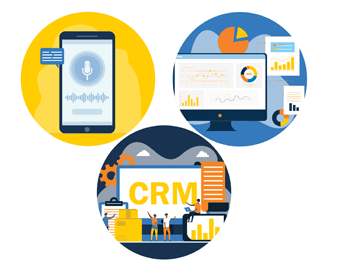
Survey Data and Recorded Survey Feedback
The 'survey data' and 'recorded survey feedback' steps are when a supervisor or analyst reviews the results of an individual survey to understand why the call was unresolved. When analyzing a survey, it is helpful to review the customer ratings and feedback before listening to the call recording, screen capture, and checking the information in the CRM system.
The general belief is that the person conducting the analysis needs to have the mindset that the customer is always right until proven otherwise. It is not uncommon for call center personnel to believe and practice that the customer is wrong until proven right. SQM considers this to be poor practice, and it can be very difficult for call center personnel who operate with this belief to increase FCR and improve customer service.
When analyzing customer feedback, it is a good practice to read customer comments and then listen to the recording from the survey. The call recording allows the listener to hear the customer's voice tone, which the text survey feedback does not always capture.
SQM captures the customer feedback, analyzes the input, and then codes the feedback based on tier 1 and tier 2 repeat call reason metrics. The value of this approach is that targeted opportunities for improving FCR, call resolution, and customer service is identified.
Call Recording
This step is based on a customer being surveyed, and their call is recorded. In this step, the call is evaluated using what SQM calls a Customer Quality Assurance approach. CQA combines call compliance metrics, judged by a Quality Assurance evaluator via a call recording, and service quality metrics, judged by a customer via a post-call or email customer survey. CQA is based on the premise of letting the customer be the judge of their own experience when contacting an organization and is one of the best practices for driving improvements in the FCR rate.
CQA uses VoC data to judge call quality to enhance, not replace, the established call monitoring process. The customer survey information alone cannot replace the entire existing QA process because there are some contact center metrics that the customer simply cannot judge (e.g., compliance and the accuracy of information). Thus, it is still necessary for the call center monitoring team to evaluate these metrics or use analytical tools to determine call compliance.
CRM Application
This step is also based on a customer being surveyed to identify which customers should be analyzed using customer relationship management (CRM) software. In this step, the call is evaluated using a CRM system. SQM's experience using the CRM system is an excellent approach for determining what happened on the call, as long as the agent took good notes.
The CRM approach works well for determining why a call was unresolved because when a call is assessed in conjunction with customer survey feedback and CRM information, there is synergy. Both assessment techniques focus on the 'outcome' versus the 'journey.' From a customer point of view, 'outcome' means whether or not the call was resolved, and from an organizational point of view, the outcome is the actual call data and notes that are in the CRM system.
Stage 3 - Improving FCR and Customer Satisfaction
The third stage is improving FCR, call resolution and customer service. There are two different areas for improving FCR, call resolution, and customer service; Agent coaching and the VoC Closed-Loop Improvement Process (i.e., IDCA – Identify, Develop, Check and Act). Both areas are designed to use customer survey feedback as the foundation and starting point for improving FCR, call resolution, and customer service performance.
The best practice for improving FCR and customer service is to always start with customer survey feedback supplemented by call recording and CRM data versus the other way around. Put simply, use the voice of the customer (e.g., post-call survey) feedback as the foundation for any type of FCR and customer service improvement initiative.
Agent Coaching
To be effective requires that an Agent understands their VoC performance and what is expected. Using an Agent VoC dashboard accessible through their desktop is a best practice to ensure that Agents have a clear understanding of what is expected of them and what they will be held accountable for. Agent desktop VoC data needs to be updated on an hourly or daily basis, and the Agents need to have access to VoC data at any time.
Figure 2 shows an example of an Agent VoC dashboard. It shows explicitly how an Agent performs for the current period, three-month rolling average, YTD performance, YTD ranking comparing them to their peers, the Agent target, and the minimum expected performance. It also shows only two metrics: overall customer satisfaction (Csat) with the Agent and call resolution performance.
By focusing on just a few VoC metrics (no more than four) and making it easier for Agents and supervisors to review their performance, call centers are more likely to see VoC performance improvements.
Figure 2: Agent VoC dashboard (Example Data)
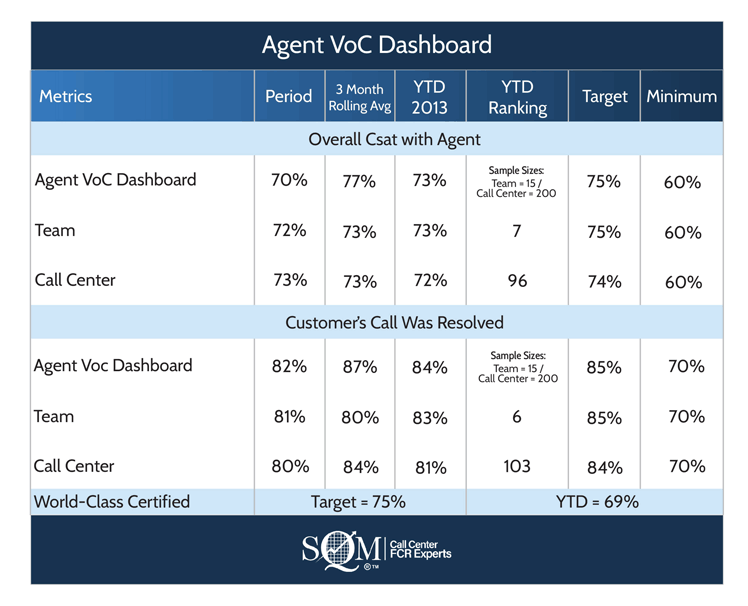
Customer Service Loop Process
The Customer Service Loop process is a well-accepted ongoing business practice for identifying what areas to improve and for implementing people, process, and technology practices that will improve FCR and customer service performance on an ongoing basis. The basic premise of the Customer Service Loop process is to form an FCR improvement team and use VoC data (e.g., post-call survey and CRM/call recording systems) to identify, analyze, and develop solutions to action for improving customer service.
Call center leaders are increasing investments in VoC programs and software that employ a Customer Service Loop process. At SQM, our customer service QA management software has a Customer Service Loop improvement process (see figure 3) feature that consists of four steps – Identify, Develop, Check, and Act (IDCA) to improve FCR and customer service performance. The four ongoing sequential steps of our Customer Service Loop IDCA process are:
1. Identify - repeat call reasons to improve by measuring FCR and Csat performance
2. Develop - a solution and implement a test pilot to reduce repeat call reasons
3. Check - to see if the test pilot was successful by measuring changes in FCR
4. Act - on customer feedback by implementing a standardized improvement plan for reducing repeat call reasons for the entire call center
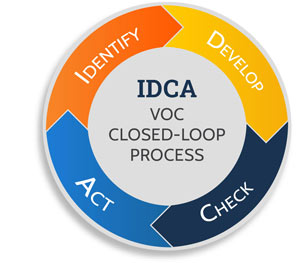
Related Links
First Call Resolution Definition First Call Resolution PPT First Call Resolution Benefits
First Call Resolution Strategies First Call Resolution Operating Philosophy CRM
Survey data Calculate First Call Resolution Rate What is a Good FCR Rate?
